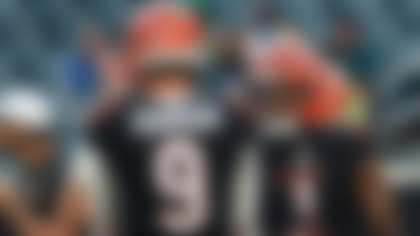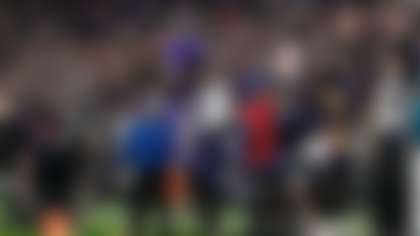Analytics expert Cynthia Frelund took data from the past 10 NFL campaigns to create historical references for personnel, scheme and matchups, identifying factors that are proven to lead to wins (or losses). She vetted the correlations with a bunch of real football people (e.g., coaches) and had her math checked out by real math people (e.g., PhDs) to make sure the model reflected reality as much as possible. Then she compared this season's personnel, schemes and matchups -- with the vetted mathematical weightings -- and simulated the season more than a million times, producing a ceiling, floor and projected win total for all 32 teams. The ceiling-to-floor range is something to home in on -- a big discrepancy means the team is projected to play in more close games.
Without further ado, here are the projected win totals for NFC teams in the 2020 campaign, ordered from most to least wins, with playoff berths noted.(Click here for the AFC figures.)
Ceiling: 11.2
Floor: 9.1
I spent a lot of time this offseason studying the impact of pre-snap alignments. I focused on whether teams were more or less successful when they used similar pre-snap alignments to run the same play or different plays (personnel, situation and opposing defense were all factored in). There are exceptions, but to simplify my findings ... Over the past eight seasons, teams that were able to run the same play multiple times or use the same pre-snap look to execute different plays earned a first down or touchdown more than 30 percent more often than teams that didn't use sequential same-looks in a drive. The 2019 Niners were exceptionally successful at this -- 46.8 percent of the times in a drive that they used the same pre-snap look, they earned a first down or touchdown. This strategy is likely to be even more useful early on in this unique 2020 campaign, when defenses are likely to have an advantage over offenses that have yet to play in real, live game situations together. Couple that with the Niners' talented defense, and you can see why my model is so high on San Francisco, especially in a division that is most likely to berth at least two playoff teams.
P.S. George Kittle earns at least seven receiving touchdowns in 69.2 percent of my model's simulations. That's a huge number -- rarely do I see projected percentages in this area over 60 percent, let alone nearly 70.
Ceiling: 11.6
Floor: 9.2
Given the constraints of this offseason, I have valued continuity at high-impact positions to an even greater degree than in past seasons. This also goes for coaches who have called plays for these specific players. The Saints' continuity -- and quality of players at every level and phase -- creates a really efficient output that far surpasses the extremely unpredictable factor of a lessened home-field advantage. The opportunity this difficult division affords New Orleans -- with projected high-volume passing offenses from Atlanta and Tampa Bay -- drives my model to forecast Michael Thomas to again pace the league in receptions, especially because Emmanuel Sanders is there. Thomas earns at least nine touchdowns in 58.9 percent of simulations. With the Saints likely to find themselves in a bunch of high-scoring, pass-happy games, my model sees Cam Jordan leading the league in sacks. The win projection reflects the impact of adding safety Malcolm Jenkins to help strengthen the spine of the defense (which is headlined by the excellent Demario Davis), and this could ultimately be the difference between playing in January and making it to February.
Ceiling: 10.8
Floor: 8.5
Over his first three NFL seasons, Dak Prescott's highest yardage total was 3,885 (in 2018) and his touchdown high was 23 (2016). Last season, Prescott passed for 4,902 yards and 30 touchdowns. Since 2015, though, no more than five total quarterbacks earned more than 4,500 passing yards each season. Last year, Prescott was one of just four quarterbacks who earned at least 30 passing touchdowns. I'm setting this up to help support my model's lowered numbers for Prescott's individual effort, while still forecasting the Cowboys as the team to beat in the East. I have Prescott earning fewer than 4,500 passing yards (57.7 percent of simulations) with between 25 and 29 touchdown passes (61.4 percent).
One important note here: The longer right tackle La'el Collins is on injured reserve, the worse the opportunity for Dallas' offense to operate smoothly. Pro Football Focus gave Collins the eighth-highest grade among all O-linemen last season.
Ceiling: 10.9
Floor: 8.8
Last year, Carson Wentz eclipsed 4,000 yards passing for the first time. In fairness, it was also just the second time he played the full 16 regular-season games -- Wentz only played 13 games in 2017 (3,296 total passing yards/253.5 yards per game) and 11 in 2018 (3,074/279.5). I'm pointing out the averages there because I project him to just barely exceed last season's 4,039-yard total (4,050, with more than 4,000 occurring in 60.2 percent of simulations). I also forecast him to pass for at least 28 touchdowns in 56.9 percent of outcomes. The race between the Cowboys and Eagles again figures to be a tight one, and both teams are projected to make the expanded playoff field.
Ceiling: 9.4
Floor: 8.8
The Bucs have Tom Brady, Rob Gronkowski and seemingly all of the hype in the world heading into the 2020 campaign. But my model warns that their schedule -- most notably, games against the Packers, Chiefs, Vikings and Saints (x2) -- could be a problem. Luckily all of those highlighted games come in Tampa, besides the season opener in the Big Easy. Still, the challenging slate creates a lower win total than what would be necessary to take the division. Last season, seven QBs passed for at least 27 touchdowns, and Tom Brady wasn't one of them. This season, though, TB12 projects to top 27 in 61.8 percent of simulations and exceed 30 in 54.9 percent. Brady has thrown for more than 30 TDs in seven seasons -- and fewer than 27 in just five of the campaigns where he's played at least 12 games.
Two more things to note: Mike Evans earns at least 1,160 receiving yards in 57.7 percent of my model's results. Gronk nets more than 610 yards in 56.9 percent, with more than five touchdowns in 59.9 percent.
Ceiling: 11.0
Floor: 8.1
Aaron Rodgers has played at least 15 games in 10 of his 12 seasons as a starter, and in those 10 campaigns, he's failed to reach 3,900 passing yards in only one (2015). My model has him topping this mark in 59.4 percent of simulations in 2020. From 2016 to 2018, Davante Adams caught 12, 10 and 13 touchdowns. He earns eight-plus this season in 62.9 percent of simulations. My model loves the combination of the team's rushing efficiency and historical play selection, as well as Rodgers' ability to adapt and make plays while in motion, which maximizes the opportunity for Green Bay's new O-line pieces (specifically at RT) to adapt. Complement this with the defensive front's ability to effectively generate disruptive pressure and Green Bay slightly edges out Minnesota for the North crown.
Side note: Za'Darius Smith led the NFL with 71 QB pressures in 2019, per Next Gen Stats. His presence fuels the Packers' projected 2020 team ranking of fourth in disruptions (how often the defense is able to come within 5 feet of an opposing QB at a relevant time and in his field of vision).
Ceiling: 10.9
Floor: 8.0
If this had been a normal offseason, I can almost assuredly say Minnesota would be my projected NFC North winner right now. However, adapting to life without players like Stefon Diggs, Everson Griffen and Xavier Rhodes, among others, creates a longer learning curve. The first five weeks of the schedule -- vs. Green Bay, at Indianapolis, vs. Tennessee, at Houston, at Seattle -- will be quite difficult, especially for the new corners and rookie wide receiver Justin Jefferson. Let me be very clear: This team has great potential and is only 0.02 games behind the Packers right now, making this an extremely close race. You'll see I have the Cardinals earning a wild-card berth just below. Minnesota has boom-or-bust traits. The Vikings' playoff odds are strong -- it's just more likely that they reach the postseason as division winners than via the wild card, as my model has the North being the least likely division to contribute a wild-card team to the NFC playoffs.
Ceiling: 9.6
Floor: 6.8
The Cardinals are the most boom-or-bust team in the NFC West. Arizona has the second-highest ceiling among the division's four teams, but the lowest floor. My model believes that the West has the strongest chance to supply at least one wild-card team to the NFC playoffs. Yes, I know the South boasts a pair of teams with higher win totals, but the close results in the West -- top to bottom -- mean every game that the division's teams play against each other will shift the odds a lot. (Remember, no team is projected to win a game with 100 percent certainty.)
According to Next Gen Stats, the Cardinals used four-plus receivers on 33 percent of plays last season, while no other team did so more than 10 percent of the time. Adding DeAndre Hopkins makes everything pass-related more favorable, as he's led the NFL in all boundary metrics (targets within 2 yards of the sideline) since 2016, with 117 targets, 39 receptions and 620 yards. Kliff Kingsbury will be able to dial up plays that present even more space for Kyler Murray and the offense to work with, while simultaneously making the most of Kenyan Drake's help in the run game. On the downside, the Cardinals allowed the most passing yards per game on first down last season (124.6), while Murray took an NFL-high 48 sacks. Arizona drafted dynamic defender Isaiah Simmons in Round 1 and right tackle Josh Jones in Round 3 -- will the rookies be able to make an immediate difference in those aforementioned problem areas? Team chemistry will determine whether the franchise returns to the playoffs for the first time since 2015 or remains a season away from contention. Go with the Cardinals making the playoffs, I say, and enjoy the ride of cheering for this upstart squad. Could Murray become the latest quarterback to take the league by storm in Year 2? Sure, why not?
Fun fantasy note: Kyler Murray rushes for more than 475 yards in 60.0 percent of simulations.
Ceiling: 9.5
Floor: 7.0
Don't blame Russell Wilson for that low floor in this projection. Wilson racks up 3,900-plus passing yards in 58.3 percent of my simulations. It's not on Chris Carson, either, as he earns more than 1,055 rushing yards in 55.7 percent of model outputs. The low floor, which drags down the median, is due to questions around Seattle's ability to consistently generate an effective pass rush. To say that my models love Bobby Wagner, K.J. Wright and Jamal Adams' production would be an understatement; I write about those three all the time. But I've programmed my models to value complementary football, since it's historically extremely correlated to success. If you believe an offense is great, then the defense has to be able to stop passes in order to reliably predict wins. A strong pressure front and shutdown corners help forecast wins -- these areas are currently unknowns in Seattle. The Week 3 contest vs. the Cowboys will go a long way in showing the potential of this team. (No, I'm not discounting the Falcons' passing offense in Week 1. I'm just generally less confident that this first week of action will be as helpful in terms of predictive metrics, due to the extremely limited offseason.)
Ceiling: 9.4
Floor: 6.7
The Rams' first three games (vs. Dallas, at Philadelphia, at Buffalo) create a very difficult start to the season -- in a year when it's likely that defenses will have an advantage in September. Why do I say that latter part? That's the strong sense I got while talking to many coaches in recent days. And also, I studied a lot of low-snap-count tendencies (to approximate early-season woes) and found that there were faster pressure/sack times, more large offensive line holes (one way I can measure potential O-line mistakes with computer vision) and more false-start penalties. Given the departures of Brandin Cooks and Todd Gurley, it's extremely hard to forecast how the offense will jell at first. The one thing that isn't so hard to forecast: Aaron Donald, who my models show is double- or triple-teamed at more than twice the rate of an average interior defender (39.8 vs. 18.9 percent), will continue to be a MAJOR problem for opposing offenses. If the Rams can start strong in those first three weeks, their playoff potential will completely change.
Ceiling: 8.5
Floor: 5.3
The Bears named Mitchell Trubisky as the Week 1 starter in Detroit. However, it's very likely that the quarterback position remains unsettled. This is why my model is a bit conservative on the total number of passes Allen Robinson will haul in: 84 -- and less than 92 in 58.8 percent of simulations. That's still a fine season and fantasy-worthy, just value accordingly. While we're talking fantasy, you should factor in the return to form of the defensive front (anchored by Khalil Mack on the outside and Akiem Hicks on the inside) if you face the Bears in fantasy and downgrade the ability to pass efficiently against Chicago. Because of this, Week 1's matchup with the Lions could be a low-scoring affair.
Ceiling: 7.5
Floor: 5.3
Due to injuries, the 2019 Falcons' presumptive starting O-line played less than 10 percent of total snaps together, which led to Matt Ryan being under pressure more than in any other season since Next Gen Stats started tracking this in 2016 (32.5 percent of dropbacks, fifth-most in the NFL). The veteran QB also posted his lowest percentage of deep attempts over that time period (8.9 percent of his throws). Statistical regression works both ways, though. It's not always a negative thing. Sometimes the final stats end up below an average expectation; thus, we can reasonably expect improvement in the following season. Positive regression! That's why you should be drafting Matt Ryan in fantasy -- and why my models forecast Julio Jones to lead the league in receiving yards (1,510-plus in 55.1 percent of simulations -- not to mention, seven-plus TD grabs in 56.2 percent).
Ceiling: 8.7
Floor: 5.7
Matthew Stafford passes for more than 4,100 yards in 60.9 percent of my 2020 simulations. And honestly, he's probably going to have to toss the ball around the yard for Detroit to win games, because the Lions' pass defense remains a huge concern. Last season, Matt Patricia's D allowed the most passing yards per game (284.4), ranked 31st in disruptions (how often the defense is able to come within 5 feet of an opposing QB at a relevant time and in his field of vision) and tied for allowing the fourth-most passing touchdowns (33). Despite the addition of first-round CB Jeff Okudah and the presumption of better injury luck on the defensive front, the Lions still project to be quite vulnerable in stopping the opposition's air attack.
Fantasy side note: Annually underrated WR Marvin Jones racks up more than 875 yards in in 56.6 percent of simulations.
Ceiling: 7.2
Floor: 5.8
Both last season and in 2018, exactly 12 quarterbacks passed for at least 26 touchdowns. In his rookie campaign, Daniel Jones totaled 24 passing TDs. Given that Jones started just 12 games in Year 1, it'd stand to reason that reaching that 26-touchdown watermark is quite achievable this season, right? Not so fast. My models caution that 24 is a far more likely outcome again in 2020. Why? Well, strong O-line play is a very important metric. As high as my model is on first-round selection Andrew Thomas -- he was my top tackle prospect -- the rookie's still going to face a learning curve. And of course, Nate Solder's decision to opt out created significant concern at the other tackle spot. Long story short: There is strong potential for Jones to be under a lot of pressure. Compound that with my model's 28th-ranked receiving corps and you have some insight on why the second-year QB likely will have to wait until next season to venture into 26-touchdown territory.
Ceiling: 7.2
Floor: 4.9
There are more positive indicators for future success -- especially on offense -- than the Panthers' low win total might suggest. However, the NFC South is my model's second-most-difficult division in the NFL this season, which amplifies the impact of Carolina's below-average defense. My model rates this team's D-line 27th, while the linebackers and corners each come in at 26th. Losing Luke Kuechly was never going to be easy, but it REALLY hurts in this unprecedented year. The importance of defending the middle of the field is likely to be even more highly correlated to wins, especially in September. Last season, Carolina allowed the third-most rushing yards per play on first down (5.21), the most rushing touchdowns on first down (20) and the most rushing touchdowns overall (31, with the next-closest team giving up just 23). While my models show Christian McCaffrey earning at least double-digit touchdowns in more than 58 percent of season simulations, and D.J. Moore earning more than 1,050 receiving yards in 55.9 percent of simulations, part of what drives these big numbers is the fact that the Panthers will ask a lot of the offense due to difficulties on defense.
Ceiling: 5.8
Floor: 3.9
Chase Young projects to be my Defensive Rookie of the Year, earning a projected seven sacks, which isn't surprising. What may be surprising is the opportunity another rookie suddenly has. Following the releases of Derrius Guice and Adrian Peterson, first-year back Antonio Gibson is poised to be trusted early in this offense. Furthermore, his presence creates a really interesting outcome in my model: It shifts second-year wide receiver Terry McLaurin's touchdown total to a higher projection. Before, I had five touchdowns as the forecast for McLaurin. Now he's creeping up closer to a projection of seven. How does this work? Gibson is a running back, but he played a lot of receiver in college. He's very multiple, which forecasts to create defensive imbalances that can be exploited by a home-run threat like McLaurin.
Follow Cynthia Frelund on Twitter @cfrelund.




























